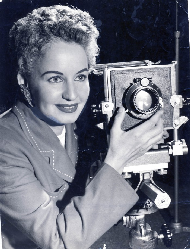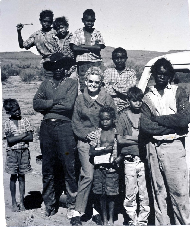Sidney Adelie Hurley 1919 - 2010


Adelie Hurley was the third of four children born to Antoinette Leighton and Frank Hurley, the famous Antarctic and World War I and II photographer. Like many children of professional photographers, once she caught the photography bug, there was no looking back. It is said that ‘Australia’s first female press photographer’, followed in her famous father’s footsteps. But according to someone who knew her well, this was not the case; she was a professional who sometimes worked with her father but was otherwise quite independent of him. ‘With determination, talent and initiative,’ says her niece, Flip Byrnes, ‘she forged her own career and, in doing so, paved the way for female photojournalists in Australia.’
From a very young age, Adelie, her twin sister, Toni, and her other siblings, Yvonne and Frank, helped their father as he developed his photographs, hovering outside the converted laundry/darkroom with a timer in readiness to give him the ’30 second warning’. But it was not her father’s influence that directed her towards photography as a career. ‘We seldom saw our dad. He was always away or photographing wars,’ explained Hurley. ‘It was not the pictures at home that stirred my interest but rather my sister's boyfriend's camera.’ Her sister’s boyfriend, Alex Stewart, was a press photographer who lent her his Graflex camera when she was seventeen. From that point on, she was hooked.
Hurley studied art in Sydney for a while, and worked as a swimsuit model, making many appearances in Pix before moving to the other side of the camera not long after the start of World War 2. Her first photographic job at Pix, apart from providing her with an excellent technical grounding, in terms of the use of light, shade, flash and point of view, was the first of a number of firsts for Hurley. She subsequently became the first female photographer on other magazines, such as AM. and the Australian Women’s Weekly. Her first assignment involved climbing the chimneystack of a Sydney Brewery which, to the amazement of her editor, she did in high heels. Other assignments completed by ‘Front Page Hurley’ involved shooting an opium den raid, hiding behind a garden while photographing bomb defusers during the submarine attack on Sydney Harbour, and photographing food queues in the Soviet Union in 1962 when such acts could have one arrested.
According to Hurley’s niece, however, the assignment she was best known for was ‘the perfume incident’. On this occasion, Hurley stowed away on a military convoy headed for Darwin at the outbreak of World War II. ‘Most truck drivers denied her passage but one agreed,’ says Byrne. Unfortunately, Hurley was detected by her perfume, the soldiers were sent home and she was dumped at Banka Banka station, a supply camp during the war that was 100 kilometres north of Tennant Creek. Not to be deterred, Hurley hitchhiked to Darwin and snuck into army camps disguised as a soldier. This resulted in more front-page bylines, this time for The Daily Telegraph.
Hurley’s career lasted well into the late 1960s. She retired to Coffs Harbour with her twin sister, Toni, in 1983. In 1999, she took a trip to Antarctica, following the course her father took when travelling with Shackleton. She died two months short of her 91st birthday in 2010.
Sources:
- Flip Byrnes, ’Pioneer in Female Photojournalism’ Sydney Morning Herald, 19 March 2010, http://www.smh.com.au/comment/obituaries/pioneer-in-female-photojournalism-20100318-qi6j.html
- Belinda Scott, ’Farewell to Adelie’ Coffs Coast Advocate, 6 March 2010, http://www.coffscoastadvocate.com.au/news/farewell-to-adelie/482724/
- 'Adelie Hurley - Australian First Female Press Photographer', Making Photographs, https://makingphotographs.wordpress.com/2012/02/08/adelie-hurley-australias-first-female-press-photographer/
- Irving Winton, 'Adelie Hurley', The pictures tell the story : outstanding images from a century of Australian press photography, Pymble, N.S.W., Angus & Robertson, 1995, pp 229-230.